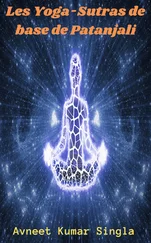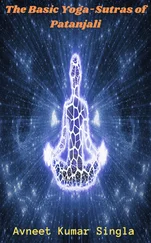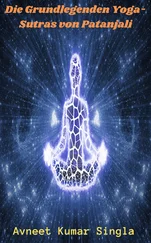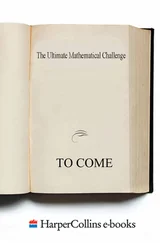The word ‘now’ can also be seen in the context of a progression from Patañjali’s previous works, his treatises on grammar and on ayurveda. Logically we must consider these to predate the Yoga Sutras , as grammar is a prerequisite of lucid speech and clear comprehension, and ayurvedic medicine of bodily cleanliness and inner equilibrium. Together, these works served as preparation for Patañjali’s crowning exposition of yoga: the cultivation and eventual transcendence of consciousness, culminating in liberation from the cycles of rebirth.
These works are collectively known as moksa sastras (spiritual sciences), treatises which trace man’s evolution from physical and mental bondage towards ultimate freedom. The treatise on yoga flows naturally from the ayurvedic work, and guides the aspirant ( sadhaka ) to a trained and balanced state of consciousness.
In this first chapter Patañjali analyses the components of consciousness and its behavioural patterns, and explains how its fluctuations can be stilled in order to achieve inner absorption and integration. In the second, he reveals the whole linking mechanism of yoga, by means of which ethical conduct, bodily vigour and health and physiological vitality are built into the structure of the human evolutionary progress towards freedom. In the third chapter, Patañjali prepares the mind to reach the soul. In the fourth, he shows how the mind dissolves into the consciousness and consciousness into the soul, and how the sadhaka drinks the nectar of immortality.
The Brahma Sutra , a treatise dealing with Vedanta philosophy (the knowledge of Brahman), also begins with the word atha or ‘now’: athato Brahma jijñasa. There, ‘now’ stands for the desire to know Brahman. Brahman is dealt with as the object of study and is discussed and explored throughout as the object. In the Yoga Sutras , it is the seer or the true Self who is to be discovered and known. Yoga is therefore considered to be a subjective art, science and philosophy. ‘Yoga’ has various connotations as mentioned at the outset, but here it stands for samadhi , the indivisible state of existence.
So, this sutra may be taken to mean: ‘the disciplines of integration are here expounded through experience, and are given to humanity for the exploration and recognition of that hidden part of man which is beyond the awareness of the senses’.
 I.2 yogah cittavrtti nirodhah
I.2 yogah cittavrtti nirodhah
| yogah |
union or integration from the outermost layer to the innermost self, that is, from the skin to the muscles, bones, nerves, mind, intellect, will, consciousness and self |
| citta |
consciousness, which is made up of three factors: mind ( manas ), intellect ( buddhi ) and ego (ahammkara). Citta is the vehicle of observation, attention, aims and reason; it has three functions, cognition, conation or volition, and motion |
| vrtti |
state of mind, fluctuations in mind, course of conduct, behaviour, a state of being, mode of action, movement, function, operation |
| nirodhah |
obstruction, stoppage, opposition, annihilation, restraint, control, cessation |
Yoga is the cessation of movements in the consciousness.
Yoga is defined as restraint of fluctuations in the consciousness. It is the art of studying the behaviour of consciousness, which has three functions: cognition, conation or volition, and motion. Yoga shows ways of understanding the functionings of the mind, and helps to quieten their movements, leading one towards the undisturbed state of silence which dwells in the very seat of consciousness. Yoga is thus the art and science of mental discipline through which the mind becomes cultured and matured.
This vital sutra contains the definition of yoga: the control or restraint of the movement of consciousness, leading to their complete cessation.
Citta is the vehicle which takes the mind ( manas ) towards the soul ( atma). Yoga is the cessation of all vibration in the seat of consciousness. It is extremely difficult to convey the meaning of the word citta because it is the subtlest form of cosmic intelligence ( mahat). Mahat is the great principle, the source of the material world of nature ( prakrti ), as opposed to the soul, which is an offshoot of nature. According to samkhya philosophy, creation is effected by the mingling of prakrti with Purusa , the cosmic Soul. This view of cosmology is also accepted by the yoga philosophy. The principles of Purusa and prakrti are the source of all action, volition and silence.
Words such as citta, buddhi and mahat are so often used interchangeably that the student can easily become confused. One way to structure one’s understanding is to remember that every phenomenon which has reached its full evolution or individuation has a subtle or cosmic counterpart. Thus, we translate buddhi as the individual discriminating intelligence, and consider mahat to be its cosmic counterpart. Similarly, the individuated consciousness, citta , is matched by its subtle form cit. For the purpose of Self-Realization, the highest awareness of consciousness and the most refined faculty of intelligence have to work so much in partnership that it is not always useful to split hairs by separating them. (See Introduction, part I – Cosmology of Nature.)
The thinking principle, or conscience ( antahkarana ) links the motivating principle of nature ( mahat ) to individual consciousness which can be thought of as a fluid enveloping ego (ahamkara), intelligence ( buddhi ) and mind ( manas). This ‘fluid’ tends to become cloudy and opaque due to its contact with the external world via its three components. The sadhaka’s aim is to bring the consciousness to a state of purity and translucence. It is important to note that consciousness not only links evolved or manifest nature to non-evolved or subtle nature; it is also closest to the soul itself, which does not belong to nature, being merely immanent in it.
Buddhi possesses the decisive knowledge which is determined by perfect action and experience. Manas gathers and collects information through the five senses of perception, jñanendriyas , and the five organs of action, karmendriyas. Cosmic intelligence, ego, individual intelligence, mind, the five senses of perception and the five organs of action are the products of the five elements of nature – earth, water, fire, air and ether ( prthvi, ap, tejas, vayu and akasa) – with their infra-atomic qualities of smell, taste, form or sight, touch and sound (gandha, rasa, rupa, sparsa and sabda).
In order to help man to understand himself, the sages analysed humans as being composed of five sheaths, or kosas:
| Sheath |
Corresponding element |
| Anatomical ( annamaya ) |
Earth |
| Physiological ( pranamaya ) |
Water |
| Mental ( manomaya ) |
Fire |
| Intellectual ( vijñanamaya ) |
Air |
| Blissful (anandamaya) |
Ether |
The first three sheaths are within the field of the elements of nature. The intellectual sheath is said to be the layer of the individual soul ( jivatman ), and the blissful sheath the layer of the universal Soul ( paramatman). In effect, all five sheaths have to be penetrated to reach emancipation. The innermost content of the sheaths, beyond even the blissful body, is purusa , the indivisible, non-manifest One, the ‘void which is full’. This is experienced in nirbija samadhi , whereas sabija samadhi is experienced at the level of the blissful body.
Читать дальше
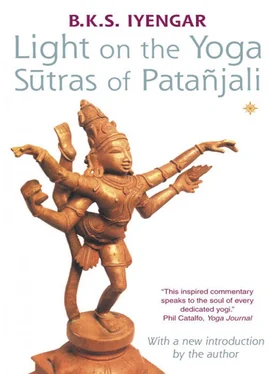
 I.2 yogah cittavrtti nirodhah
I.2 yogah cittavrtti nirodhah